Background information; by edgardowelelo@yahoo.com
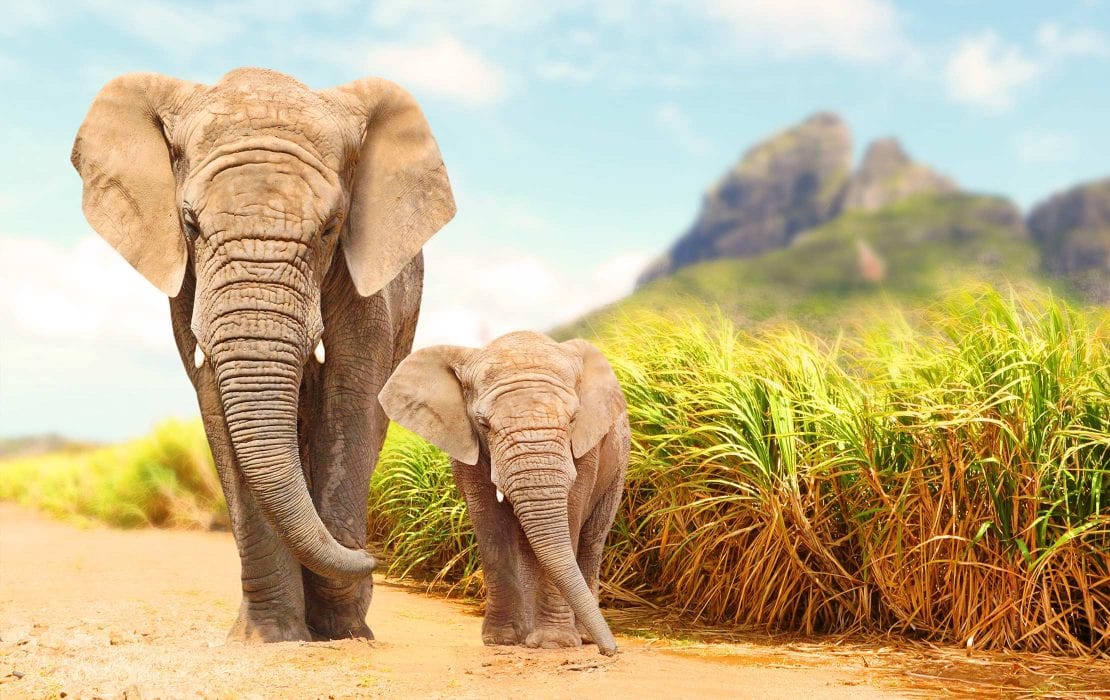
- Location; On the northernmost coast of Australia’s Northern Territory, around 150 miles (250 km) east of Darwin.
- Australia is the driest inhabited continent on Earth, but for a brief period of the year, the tropical belt that stretches across the northern third of the country is awash with fresh water and spectacular concentrations of birds. In December, midsummer storms begin to sweep inland from the Indian Ocean, and over the next few months’ rivers burst their banks, flooding the low – lying land and creating enormous wetlands. Kakadu National Park lies on the coast in the extreme north of this tropical wet – dry zone. It is among the best places to watch birds in Australia, with more than 280 species being listed. Although the rain forests of the northeast support a more varied bird life, few other areas offer such good bird – viewing opportunities.

- TRANSIENT BIRD DIVERSITY
The wet season in Kakadu usually lasts until April, by which time much of the park is underwater and its extensive stands of paper bark trees have turned into a flooded woodland accessible only by boat. Huge numbers of water birds flock to the area sometimes traveling great distances across Australia’s arid interior to feed or breed in this temporary swampland. They include – whistling ducks, shelducks, and vast numbers of Magpie Geese, which graze on the green carpet of sprouting wild rice plants. Endemic to Australia and Papua New Guinea, these noisy waterfowl are polygamous breeders - each male mates with two or three females, which share the same nest. Egrets, herons, and storks wade through the shallows to hunt for fish, while flotillas of Australian pelicans patrol the more open areas. In May and June, Kakadu’s wetlands slowly start to shrink, and both fish and the birds that eat them become concentrated in isolated pools, or billabongs. By August to September, these water holes offer impressive bird watching. Although, best known for its water birds, Kakadu is also home to a rich assortment of land – based species including birds of prey, flycatchers, honey eaters, and parrots. The rare Gouldian Finch and Red Goshawk are among its residents. In 1981, Kakadu was listed as a World Heritage Site.
GATHERING OF GEESE
During the wet season, floodwaters pour into the flat lowlands of Kakudu National Park. For a few months these lush wetlands attract a wealth of water birds, including flocks of Magpie Geese.
- WHAT TO SPOT
- Length; 5 in (13 cm)
- Weight; 14 g
- Migration; Partial migrant.
- Habitat; Grassy plains with trees, woods and scrub.
- The Gouldian Finch can have a red, black, or more rarely, orange – yellow face, but is distinctive in all variants. Black – faced birds make up most of the population. Throughout the year, the Gouldian Finch depends upon grass seed as its primary food. It builds nests in tree holes in open, grassy woodland. Outside the breeding period, it is found in a wide variety of woodland habitats. In the dry season, it gathers to drink at water holes. This once abundant finch has, however, been reduced to fewer than 2,500 birds in the wild, possibly because of its popularity as a caged bird.
- MAGPIE GOOSE (Anseranas semipalmata)
- Length; 30 -33 in (75 – 85 cm)
- Weight; 2 – 2.7 kg
- Migration; partial migrant
- Habitat; Tropical flood plains, swamps, and damp grassland, within 50 miles (80km) of the coast.
- A primitive, aberrant (un usual) goose that provides the evolutionary link between wildfowl and screamers, the Magpie Goose has unusual features such as partially webbed feet and a long hind toe. Both the male and female are highly vocal. Some males, mate with two females, which lay eggs in the same nest. The pair or trio usually bond for life.
- COMB – CRESTED JACANA
- RED GOSHAWK
- Location; South Atlantic Ocean, approximately (860 miles) 1,390 km southeast of the Falkland Islands.
- One of the bleakest and most isolated wildernesses on EARTH, this small and mountainous group of islands lies where the south Atlantic meets the often stormy Southern Ocean. The archipelago is a haven for an extraordinary density of wildlife, including about 30 million breeding birds. South Georgia attracts such magnificent gatherings of seabirds for two reasons. First, there are plenty of safe nesting sites: wide beaches, sea cliffs, steep slopes covered with hummocks of coarse tussock grass, and rocky off shore islets. In addition, the archipelago is also surrounded by cold waters rich in fish, krill (tiny crustaceans), and other marine life, which provide an abundant supply of food for the adult birds and their chicks.

- BIRD – RICH WILDERNESS; South Georgia is largely uninhabited. The islands’ only visitors are the crews of passing fishing vessels and the tourists who arrive by sea, mostly between December and March during the Southern summer, when the seabird breeding season is well underway. Probably the most impressive sea bird seen at South Georgia is the Wandering Albatross, which has the largest wingspan of any bird. Up to 4,000 pairs nest here – 15 percent of the world population. There are also 100,000 breeding pairs of Black – browed Albatrosses and 80,000 pairs of Gray – headed Albatrosses. Many of these species of albatross are in decline, so South Georgia is vitally important to their conservation. A wide variety of smaller “tubenoses” breed on South Georgia, including petrels, storm petrels, diving petrels, and prions. Cape petrels nest on high rock ledges on the coast. Antarctic Terns make their nesting scrapes among rocks or on beaches. South Georgia is also home to vast colonies of Penguins, particularly King Macaroni, and Gentoo penguins. A single hill side on Bird Island (off the main island of South Georgia) is the breeding ground for 35,000 of the archipelago’s two million pairs of Macaroni Penguins. Very few other birds can survive on South Georgia’s rugged terrain. They include yellow – billed Pintail and the island’s only endemic species – the South Georgia pipit, which is under threat from introduced rats.
- CLIFF – TOP NURSERY
The precipitous, tussock grass covered sections of coastline on South Georgia and neighboring Bird Island provide popular nest sites for the Gray – headed Albatross.
- WHAT TO SPOT
- ANTARCTIC TERN (Sterna vittata)
- Length: 14 -15 ½ in (35- 40 cm)
- Weight: (150 -175)
- Migration: Migrant
- Habitat: Breeds on rocky islets, otherwise favors edges of Ice, rocky coasts, and beaches.
- Before migrating to the tip of South America and Africa, the Antarctic Terns breed on islands in the Southern Ocean. In its breeding plumage, this bird is very similar to the Arctic Tern, although it is larger and bulkier. A non-breeding Antarctic Tern is distinguished from its close relative by its grizzled crown, white forehead, and a red bill and legs. The plumage of the juvenile is white while the bill and legs are black.
2 . BLACK – BROWED ALBATROSS (Thalassarche melanophrys)
- Length: 31 -38 in (80 – 96 cm)
- Weight: 6 ½ - 10 Ib (2.9 – 4. 6 kg)
- Migration: Migrant
- Habitat: Open Ocean or Sea, breeding only on bare rocky areas and slopes on Islands.
- The Black – browed Albatross takes its name from the tiny dusky mark running through the eye. It is mostly white with gray highlights, yellowish orange webbed feet, and an orange bill, tipped darker orange. It flies for hours over the sea, looking for fish, krill, cephalopods, salps, and Jellyfish. Unlike many albatrosses, it breeds annually. One of the most common and widespread of the smaller species of albatrosses (collectively known as Mollymawks), this species has declined dramatically in recent years due to overfishing and longline fisheries. It nests on terraces on top of coastal cliffs or steep slopes up to 1,000 ft. (300m) above sea level.
- SUBANTARCTIC SKUA
- SOUTHERN GIANT PETREL
- Length: 33 -39 in (85 – 100 cm)
- Weight: (3.8 – 5kg)
- Migration: Migrant
- Habitat: Open Ocean and Sea, breeds on exposed beaches, gravel areas, and tussock grass.
- The southern Giant petrel occurs in two forms: one is largely dark brown with a white head and neck, and the other, which is less common, is completely white, except for a few scattered dark feathers. Large and aggressive, this bird is a scavenger, detecting food by smell, and feeding on penguin and seal carcasses. It also kills live birds and often gathers near trawlers and sewage outfalls. Like many albatrosses, its decline may be linked to longline fishing.
Location: in East Africa, 150 Miles (240 km) north of Nairobi, the capital city of Kenya.
Part of a chain of lakes along the Great Rift Valley in East Africa. Lake Bogoria covers an area of 41 square miles (107 square km). The lake is dominated by many hot springs that pour super-heated water into its highly alkaline waters. These caustic waters have very little plant or animal life, so they lack the flocks of migrant ducks, geese, and waders that stop to refuel on the region’s freshwater lakes. In their place are up to a million Lesser Flamingos at times, plus small numbers of Greater Flamingos.
TOXIC FEEDING GROUND
The huge flocks of flamingos assemble to feed on the blue – green algae and swarms of brine shrimp that smother the surface of the lake. Due to the toxic environment, this vast food supply is un available to fish, amphibians, mammals, and most birds, so flamingos have exclusive access. Their populations can reach exceptionally high densities. For reasons that remain un clear, flamingo numbers at Lake Bogoria fluctuate dramatically from one season to the next. Without warning, virtually the Lake’s entire population of flamingos may shift to nearby Lakes Nakuru or Naivasha, returning equally suddenly months later. The only other birds to enter the lake are the Black – necked Grebe and Cape Teal, mostly where incoming springs lower the water’s salinity. Large numbers of African Fish Eagles are attracted to the lake to hunt the flamingos - it is not unusual to see eight or more perched in a single tree at the water’s edge. Others species that prey on the flamingos include Marabou storks and Steppe and Tawny eagles. Lake Bogonia Natural Reserve extends beyond the Lake to incorporate a variety of other habitats that support a rich selection of tropical African birds, from bee - eaters and barbets to widow birds, weavers, and hornbills. Resident birds of prey include the Secretary bird, while the reserve’s wetlands attract water birds such as the Goliath Heron. In 2000, Lake Bogoria was designated a wetland of international importance under the Ramsar Convention On Wetlands.

FEASTING FLAMINGOS
Masses of Lesser Flamingos stand knee – deep in the hut, stinking waters of Lake Bogoria. The flamingos have tough skin on their legs to protect against caustic salts in the lake’s waters.
WHAT TO SPOT
- RED – AND YELLOW BARBET (Trachyphonus erythrocephalus)
- Length: 8 – 9 in (20 – 23 cm)
- Weight: (40 – 75 g)
- Migration: Non – migrant.
- Habitat: Open woodland and wooded savanna, even desert like terrain, but with trees.
- One of the most distinctive barbets, the Red – and - Yellow Barbet has a striking head pattern and bold white spots on its upperparts and tail. It is also known for its ability to live in close proximity to humans, taking advantage of the feeding opportunities presented by house hold waste. Its natural diet, however, includes fruit, seeds, insects, lizards, and even small birds and their eggs. The bird mainly forages on the ground, moving in groups that methodically search and probe natural and manmade crevices for food. The Red – and yellow Barbet is dominant over other species of barbet within its range. The Red – and – yellow Barbet builds its nest in an earth bank or termite mound, with the nest chamber reached by a short tunnel slightly less than 3 ½ feet(1m) long. In each group, the primary male mates with one female and also incubates the eggs. The rest of the group act as “helpers”, bringing food and perhaps excavating the chamber.
- SECRETARY BIRD (Sagittarius serpentarius)
- Length: 3 ½ 5 ft. (1.5 – 1.5 m)
- Weight: (2.3 – 4.3 kg)
- Migration: Non migrant
- Habitat: Open and bush grassland, large grain farms, and semi desert with scrub.
- Unlike any other bird of prey, the secretary bird has extraordinarily long legs, a long wedge – shaped tail, and a crest of black feathers on the back of its head. It gets its name from the crest, which resembles a row of quill pens, once used by secretaries. It spends most of its time on the ground and has the ability to run fast, taking off with a flapping run and sometimes soaring high on thermals, like other birds of prey. Grasshoppers, beetles, small rodents, and snakes make up its main food items. Most of its prey is killed on the ground, sometimes with its bill, but also by stamping on it. It is often attracted to bush fires, where it will search for dead insects and other small animals. The Secretary bird does not migrate, but will move some distance to find food, responding to rainfall, fires, and cropping or grazing activities. It usually nests in the top of an acacia tree in a stick nest lined with grass, wood, and animal dung. A pair may raise up to two young and some breed twice a year. The secretary bird is famous for killing snakes, tackling even venomous species. It Kills a snake by holding it under its feet and tearing it up, or flying up with the snake in its bill and dropping it on the ground. A fast runner, the secretary bird chases its prey, which when caught is stamped to death, the talons aiming at the head of the prey.
- GOLIATH HERON (Ardea goliath)
- Length: (1.4 – 1.5 m)
- Weight: (4.4 kg)
- Migration: Non – migrant
- Habitat: Rarely found far from water, both inland and on the coast.
- The world’s largest heron, the Goliath Heron is nearly twice the size of the Purple Heron (A. purpurea) it superficially resembles. It may be found feeding in deeper water than other herons and can stand for hours waiting for the large fish that make up a major part of its diet. It is solitary and rarely found near settlements or other sources of human disturbance. The Goliath Heron flies slowly with legs held at an angle below the body, not horizontally as in other herons. Able to cover long distances, it flies with slow and heavy wing beats.
- AFRICAN FISH EAGLE (Haliaeetus vocifer)
- Length: (63 – 73 cm)
- Weight: (2 – 3.5 kg)
- Migration: Non – migrant
- Habitat: Large rivers, Lakes, dams, coastal estuaries.
- Widespread in Africa, South of the Sahara, the adult African Fish Eagle has a striking white head and breast, dark brown wings, and a chestnut belly and back. Its large bill is two - toned yellow and black in color. The Juvenile is mottled brown and much harder to distinguish from other eagles. A large bird, the African Fish Eagle has a wingspan of almost 6 ½ feet (2m) and, similar to other raptors, the female is much bigger and heavier than the male. The species has a loud ringing call and is very vocal, both on its perch and in flight. As its name suggests, the African Fish Eagle feeds mainly on fish. It scours the surface of the water from a perch, swooping down on to its prey with a backward swing of the feet, and seizing the fish in its large talons. It will also steal food from other species such as herons, and occasionally take other types of prey such as small mammals, young waterfowl, or carrion. It breeds during the dry season, building a large nest, made of sticks and pieces of wood on a tree. Incubation of the eggs takes about 42 – 45 days.
- Location: Rajasthan, northern India, about 120 miles (190 km) south of New Delhi between the cities of Jaipur and Agra.
- Named after an ancient Hindu Temple in the Park, Keoladeo is also known as Bharatpur Sanctuary, which is the nearest town. Formerly a duck – hunting reserve of the Maharajas, this patchwork of seasonal marshes, tropical dry forest, and scrub lies in the Gangetic plain, the vast lowland region that covers much of north central India. It is firmly established as one of the best bird watching destinations in southern Asia. Nearly 380 bird species have been recorded within the park boundaries – about a quarter of the total number found in the entire Indian Subcontinent. The park is an important breeding ground for thousands of storks, herons, and cormorants, which in winter are joined by large numbers of ducks and other migrant water birds from central Asia, China, and Siberia.
- GREEN OASIS
Keoladeo’s unspoiled natural appearance is misleading because the lush wetlands are of artificial origin. The landscape that are seen today was created in the 1850s to store the flood waters of the summer monsoon. During the monsoon, water is channeled from the swollen Gambhir and Banganga rivers into a system of canals, sluices, and embankments to form extensive marshes and pools up to 6 ½ ft. (2m) deep. Following the banning of hunting in Keoladeo in the 1970s, about 11 square miles (29 square km) of the site became a national park in 1982, and three years later it was declared a World Heritage Site. One of the reasons that Keoladeo is a magnet for birds is the aridity of the surrounding countryside, which has a low rainfall and extremely hot, dry summer summers. For much of the year, the park becomes an oasis of green in an otherwise parched region. In its wetland areas, typical breeding birds include the Sarus Crane, Greater Adjutant, Painted stork, Asian open bill, Darter, Indian Pond Heron, and Pheasant – tailed Jacana, as well as various species of egret, spoonbill, ibis, pelican, and cormorant. Many birds of prey, including at least nine (9) species of eagles, hunt in the park at different times of year and its dry areas are home to a rich array of land birds.
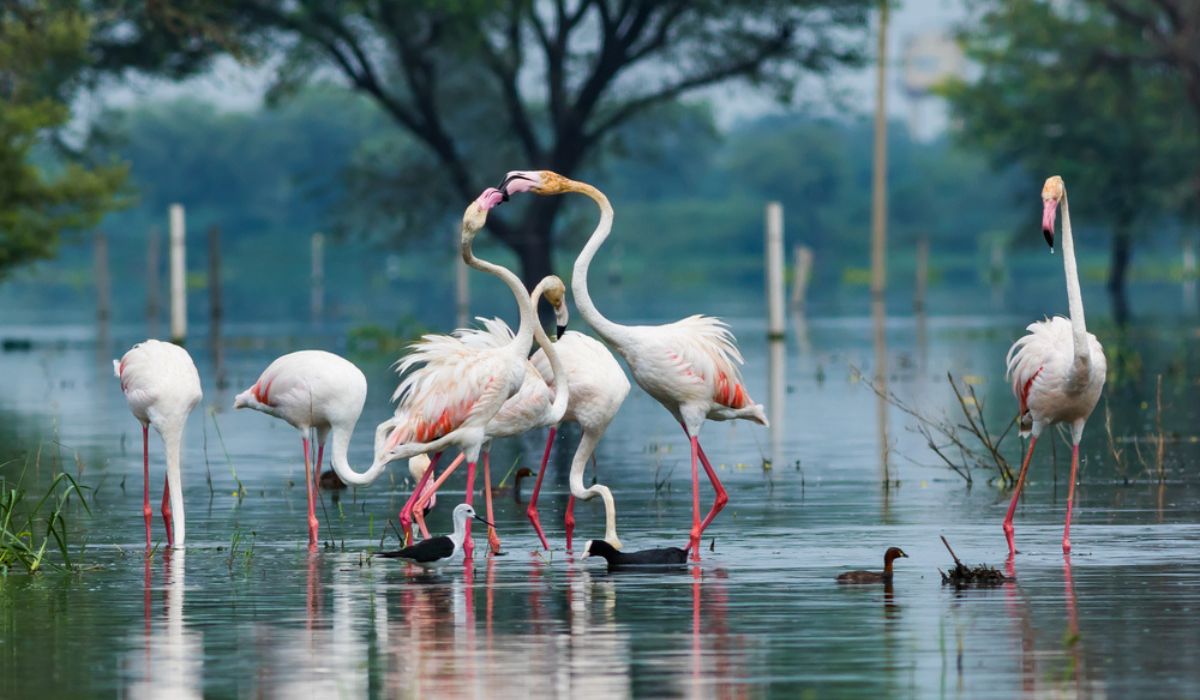
- WETLAND NESTING
Thickets of acacia trees scattered throughout the seasonal wetlands of Keoladeo provide ideal nest sites for colonies of water birds, such as the painted storks.
- WHAT TO SPOT
- INDIAN ROLLER (Coracias benghalensis)
- Length: (32 cm)
- Weight: (150 – 175 g)
- Migration: Partial migrant.
- Habitat: Open farmland, wooded groves, road sides, villages, parks and other open areas.
- A stocky bird with a brown back, the Indian Roller is particularly spectacular in flight: its azure stripe across the wings being visible from a distance. Its crown, inner wing, belly, and outer tail are turquoise and the flight feathers are mostly dark blue. The throat is streaked white. It feeds on insects, rodents, and reptiles.
- PHEASANT TAILED JACANA (Hydrophasianus chirungus)
- Length: (31 – 58 cm)
- Weight: (125 – 200g)
- Migration: Partial migrant.
- Habitat: Shallow wetlands with plenty of vegetation, particularly waterlilies.
- With its long, gracefully curved tail, the Pheasant – tailed Jacana is unmistakable. The sexes look alike, although the female is somewhat larger than the male, common when it is the dominant partner. Unlike other jacanas, this species has a different nonbreeding plumage – its tail becomes much shorter, and its colors become subdued. The Pheasant – tailed Jacana spends most of its time walking on the floating vegetation of its aquatic habitat, only occasionally coming onto dry land or swimming in the water. At such times it remains remarkably inconspicuous, but when it takes flight, the dazzling white of the outstretched wings makes the bird stand out. When it is at rest, this whiteness maybe visible as a panel down the flank, although it is often partly hidden by the brown feathers of the wing coverts, which protect the wings as the bird walks through grass and reeds. Another feature that usually remains hidden beneath the wings is the sharp spur at the bend of the wing, which it uses during fights with rivals in the breeding season.
- GADWALL (Anas strepera)
- Length: (46 – 55 cm)
- Weight: (875 – 975 g)
- Migration: Migrant
- Habitat: Freshwater lakes and marshes in lowland areas; also coastal wetlands.
- The Gadwall is one of the more widespread dabbling ducks. The male is mostly gray with black tail coverts, but shows a prominent white wing patch in flight. The female resembles a female Mallard but shares the white wing patch of the male Gadwall and has an orange - sided bill. This species is less gregarious than other dabbling ducks and forms relatively small flocks outside the breeding season. It nests on the ground, often some distance from the water, and the chicks start life on a diet of insects.
- INDIAN POND HERON (Ardeola grayii)
Location: At the mouth of the Danube River on the western coast of the Black Sea on the border between Romania and Ukraine.
- Before draining into the Black Sea, the Danube River divides into three main branches and countless smaller channels to form the largest delta in Europe, covering 1,610 square miles (4,175 square km). This vast wetland is one of the last truly great European wildernesses. Heavily laden with silt, the murky brown river water disperses throughout the delta, giving rise to a complex mosaic of diverse habitats. More than 315 species of bird, including about 175 breeding species, have been recorded here, ensuring that the Lower Danube region ranks among the top birding destinations in Europe. In 1991, approximately half of the delta’s core area was inscribed as a UNESCO World Natural Heritage Site.
WATER BIRD DIVERSITY
The Danube Delta consists of a complex network of watercourses and shallow lakes and lagoons that are carpeted with waterlilies in summer. There are also tree – fringed islands, and floating islets of decaying reeds called plaur, interspersed with extensive reed beds, marshes, and seasonally flooded plains. The area is of massive importance for its breeding water birds. It supports significant numbers of Pygmy cormorants and Dalmatian pelicans, together with most of the European populations of Great White Egrets and White pelicans. In addition, the delta’s islands host large breeding colonies of Glossy Ibises, Eurasian spoonbills, Eurasian Bitterns, and various herons. Whiskered Terns elegantly hawk for insects over the surface of virtually every pool, and the reed beds are teeming with warblers. Patches of riverine woodland are home to nesting raptors and woodpeckers, while drier areas have shrikes, European Rollers, and Red – footed Falcons. In April or early May, the northward passage through the delta of several million migratory birds can be spectacular and from November onward, the delta provides shelter for wintering flocks of waterfowl, including at times 500,000 white – fronted Geese and 45,000 Red - breasted Geese – almost the entire world population of this rare species. But perhaps the most impressive resident is the White – tailed Eagle, up to 40 of which overwinter in the delta.
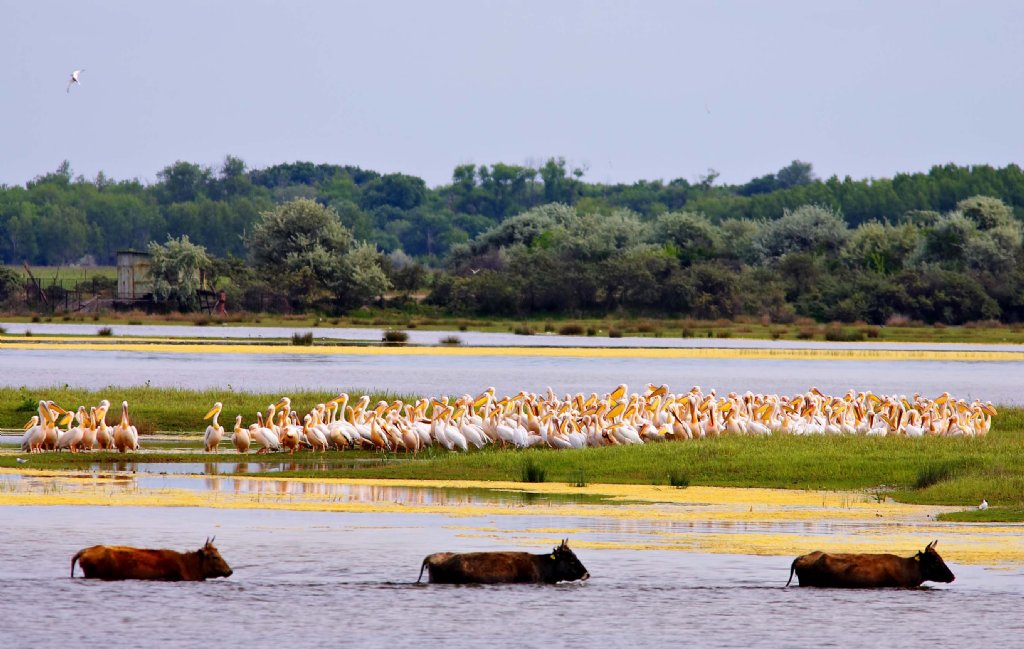
PELICAN SANCTUARY
A group of White Pelicans gather on a nest platform hidden amid the reed beds. There are about 2,500 breeding pairs of this species in the Danube Delta.
- WHAT TO SPOT
- RED – BREASTED GOOSE (Branta ruficollis)
- Length: (53 – 55 cm)
- Weight: (1.1 - 4g)
- Migration: Migrant
- Habitat: Breeds on tundra close to rivers, winters in open steppes among pasture and crops.
- Although strikingly patterned, the chestnut head and neck of this unmistakable goose are inconspicuous at long range, when the species appears simply black and white. The Red – breasted Goose breeds in northern Russia and winters almost entirely at five sites in Bulgaria and Romania. Its range continues to decline due to climate and land use changes.
- EUROPEAN ROLLER (Coracias garrulus)
- Length: (31 cm)
- Weight: (150g)
- Migration: Migrant
- Habitat: Breeds on sunny lowlands with patches of woodland, winters on dry, wooded African savanna.
- Predominantly electric – blue, with a chestnut back and wing patches, the European Roller is a large - headed, long – necked roller. It spends long periods on a perch looking for prey. It is an intercontinental migrant; almost the entire population winters south of the Sahara. In spring, the species makes spectacular mass movement northward along the East African Coast.
- DALMATIAN PELICAN (Peleanus crispus)
- RED – FOOTED FALCON (Falco vespertinus)
Location: In northeastern South Africa, bordered by Mozambique to the east and by Zimbabwe to the north.
- One of Africa’s oldest game reserves, Kruger was established in 1898, and in 1926 it became a national park that today covers almost 7,350 square miles (19,000 square km). The reserve lies within an enormous zone of grassland and scrub, which stretches across the highland plateau of northeastern South Africa and reaches into neighboring Mozambique and Zimbabwe. This varied subtropical landscape, called BUSH VELD, is a patchwork of open grassy areas and impenetrable thorny thickets, strewn with boulders, rocky outcrops, and stunted trees.
MIGRATION DESTINATION
Kruger National Park is best known for its herds of grazing animals and for the carnivores that hunt them, but it also supports an extraordinary diversity of birdlife, so it can rank among the most exciting bird watching destinations in Africa. More than 520 species of birds have been recorded in the reserve, including about 250 species that occur year round, together with a similar number of migratory species or nomadic wanderers. The majority of the area’s seasonal visitors arrive in summer (October to March) with the rains. They include many long - distance migrants from Europe and central Asia, such as the Barn Swallow, European Roller, and Willow Warbler. Several European and Asian birds of prey also migrate to Kruger such as the Eurasian Hobby and Red – footed Falcon. A host of open – country African birds are found in Kruger all year, from the Secretary bird, which stumps on snakes and other prey with its extremely long legs, to a wide range of bee – eaters, shrikes, pipits, larks, and francolins. The wooded areas are home to species such as wood hoopoes, mouse birds, starlings, and the massive – beaked Southern Ground Hornbill. However, one of the main highlights of the reserve is its impressive variety of birds of prey. During the winter dry season (April to September), birds concentrate at waterholes, rivers, and artificial dams. In summer, birds are spread throughout the reserve and many species raise young.
WHAT TO SPOT
- SADDLE – BILLED STORK (Ephippiorhynchus senegalensis)
- Length: (1.4 - 1. 5m)
- Weight: (6 kg)
- Migration: Non migrant
- Habitat: Mainly in large open wetland habitats, but also in open Semi – arid areas.
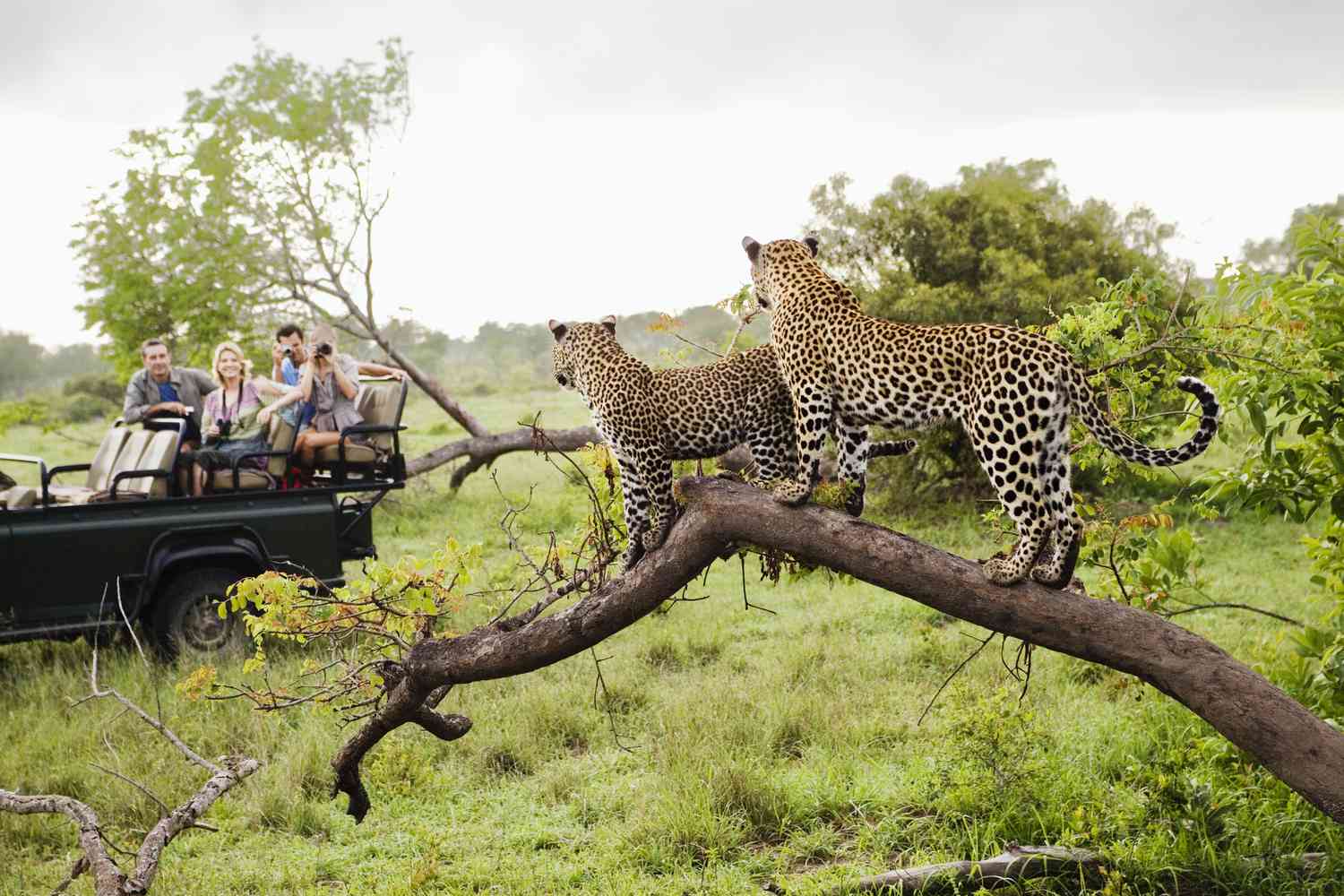
Aptly named, the Saddle - billed stork has a huge black and red bill, with a yellow frontal “saddle”. Its plumage is a contrast of white and an iridescent black. The female can be distinguished from the dark – eyed male by its bright yellow iris. The species inhabits the plains of Africa south of the Sahara Desert, where it lives in pairs or small family groups. Juveniles closely follow their parents and learn to hunt by imitating them as they stab a fish and frogs.
- PURPLE CRESTED TURACO (Tauraco porphyreolophus)
- Length: (40 – 46 cm)
- Weight: (225 – 250 g)
- Migration: Non migrant
- Habitat: Coastal and gallery forest and broad – leaved woodland.
The purple – crested Turaco is aptly named for its dark violet crest. Its iridescent plumage is mainly green and violet in color. It has bright red flight feathers. In the past, these red primary feathers were much prized as adornments by the Zulu tribe. The Purple – crested Turaco feeds mainly on fruit and berries, but also accepts food from bird feeders in sub urban gardens. The bird is generally found in pairs or in small family parties, though larger congregations also occur.
- WHITE FRONTED BEE - EATER (Merops bullockoides)
- NATAL SPUPFOWL (FRANCOLIN) Pternistes natalensis)
Location: A wide bay on the Irish Sea Coast of northwest England (UK).
- Set against the magnificent backdrop of windswept salt Marshes and the rolling hills of the Southern Lakes District. Morecambe Bay is one of the largest and most important estuarine areas for birds in Europe. The vast intertidal mudflats and Sand flats of this shallow bay teem with abundant invertebrate life such as lugworms, cockles, mussels, and shrimp, attracting enormous numbers of waders, ducks, and geese to feed. During peak migrating periods, thousands of shorebirds pause here to rest and feed when moving up and down Britain’s west coast in spring and fall, and the bay is also a vital overwintering or breeding location for a wide variety of species.
INTERTIDAL BIRD LIFE
At extreme low tides in spring the sea may drain up to 7 miles (12 km) away from the high – water mark and the exposed mud and sand stretches as far as the eye can see the biggest continuous intertidal area in Britain, covering about 118 square miles (305 square km). On the bay’s picturesque north and east sides, the tidal flats are bordered by low – lying salt marshes. Morecambe Bay hosts globally significant numbers of 11 species of birds, including ducks such as Northern Pintail and Common Shelduck and waders such as Red knot, Dunlin, Common Red Shank, Eurasian Curlew, and Eurasian Oystercatcher. Some of these waders use the bay as a stopover during their migrations: others remain throughout the winter. In particular, the bay regularly supports 65,000 – 70,000 Red knots in winter – over 15 percent of that species’ entire wintering population in Europe and North Africa. At high tide, when the mudflats are flooded by the incoming seawater, the salt marshes and raised gravel beaches that fringe the bay offer a temporary refuge to masses of waders. Occasionally a Peregrine Falcon or Merlin triggers alarm among the wader flocks. The fast – moving waters and treacherous quick sands of Morecambe Bay is safe only at low tide and with a professional guide. Among the best vantage points from which to observe the spectacular high - tide water roosts safely are HEST BANK, the sea walls at Heysham, and Flookburgh Marshes.
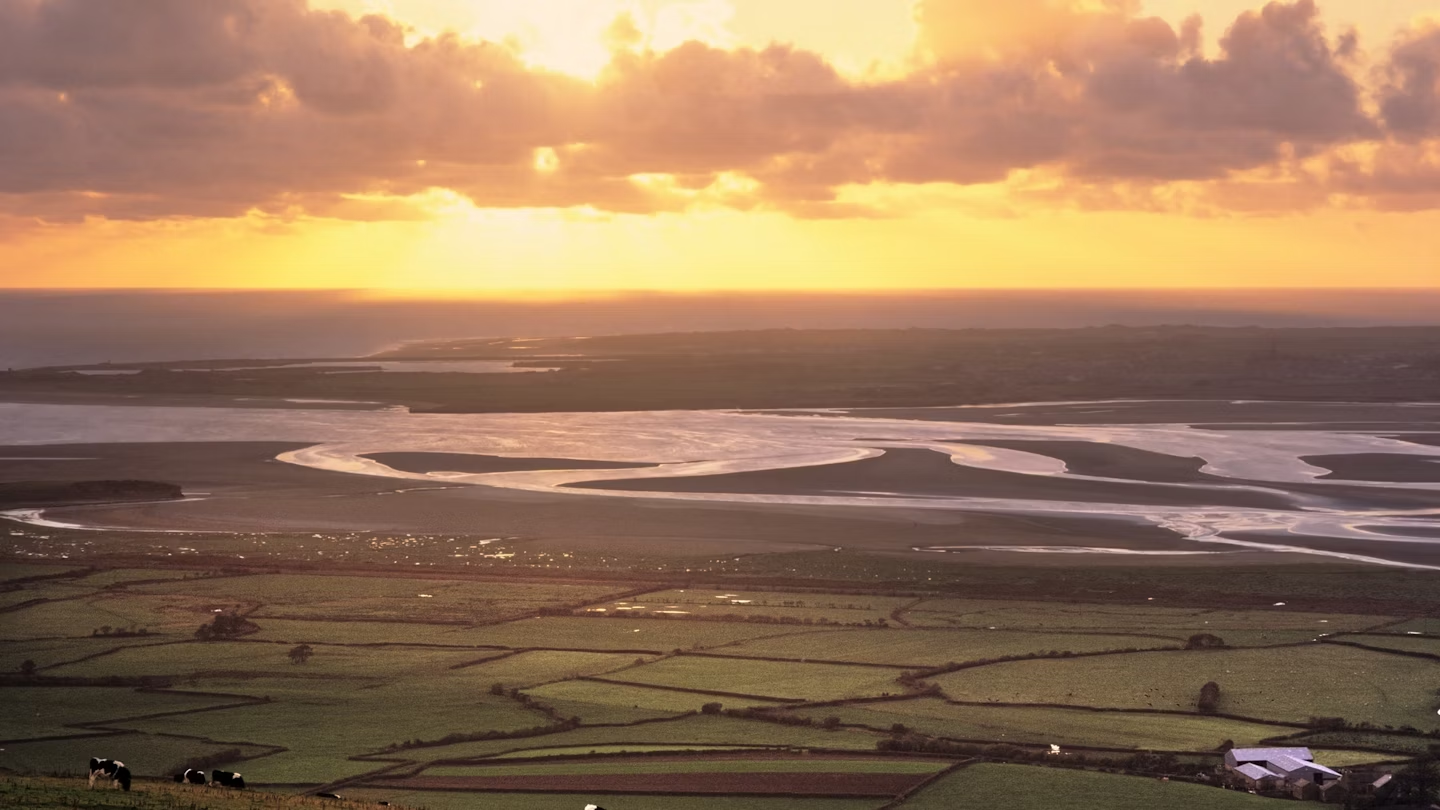
WHAT TO SPOT
- MERLIN (Falco columbarius)
- Length: (24 – 32 cm)
- Weight: (175 – 225g)
- Migration: Migrant
- Habitat: Tundra, arctic alpine and temperate areas in summer; open places and coasts in winter.
The Merlin relies on speed and agility to hunt its prey, which mainly consists of small birds such as larks and pipits, although it also eats a variety of large flying insects. It hunts by flying fast and low, often less than 3 ¼ ft. (1m) above the ground, in order to surprise its prey. The male Merlin is blue - gray above, and cream to rufous – buff below, with dark streaks; its pale gray tail has a black band. The female is brown above and has cream, brown – streaked underparts, its banded tail being brown and cream. Merlin nests on the ground throughout most of its range, but also uses abandoned nests of other birds, especially crow’s nest. It breeds from April to June and 3 – 6 eggs are laid. The male’s call is a quick, sharp “Kik – Kik – ki -Kik,” while the female has a deeper, more nasal, “Kee – Kee – Kee – Kee,” but both are quiet when nesting and in winter.
- DUNLIN (Calidris alpina)
- Length: (16 – 22 cm).
- Weight: (45 – 60 gm)
- Migration: Migrant
- Habitat: Breeds on Tundra, moors, and marshes; winters mainly on muddy coastal habitats.
- One of the most familiar shorebirds, the Dunlin’s breeding plumage is characterized by a conspicuous black patch on its white belly. At this time of year, in common with many other waders, its upperpart feathers are dark brown, scalloped with broad rufous and white fringes. Its long decurved bill is black, as are in short legs. The juvenile has black and cream stripes on its back and black streaks on its buff underparts. In summer, the Dunlin is a truly circumpolar species, breeding in the northernmost parts of Alaska, Scandinavia, and Russia. As fall approaches, this species migrates south to winter primarily on coastal wetlands in temperate parts of the Northern Hemisphere. Outside the breeding season, Dunlins often gather in enormous flocks on favored feeding grounds. In flight, such flocks are often compact and seem to wheel and circle as one entity, with the birds executing sudden changes of direction in perfect unison. The Dunlin’s cry is a thin, reedy, vibrant “shree” or rasping “treerrr”. Like most shorebirds, it lays 4 eggs.
- COMMON RINGED PLOVER (Charadrius hiaticula)
- Length: (18 – 20 cm)
- Weight: (55 – 75 g)
- Migration: Migrant
- Habitat: Coastal in Arctic, Sub arctic, and temperate Zones; also breeds in tundra areas and along rivers.
- A little bird, the common Ringed Plover has pronounced head markings, a white collar, and a broad black band on its breast. The male has a larger band than the female. This bird is a classic “leap – frog” migrant – the most northerly breeding populations winter the farthest south, while the birds breeding to the south undertake progressively shorter migrations.
- EURASIAN WIGEON (Anas (Mareca) penelope)
Location: The Bering Sea about 280 miles (450 km) off the coast of Southwest Alaska and 500 miles (800 km) east of Siberia (Russia).
- Saint Paul Island is the largest of the Pribilofs, an isolated group of four (4) islands, lying to the north of the Aleutians, a great arc of volcanic islands strung out across the Bering Sea. This rocky outpost in the middle of the Bering Sea hosts some of the most important seabird colonies in the Northern Hemisphere. Each year during the brief subarctic summer Saint Paul’s rugged coastline comes to life as huge numbers of Ocean – going birds return to land to breed. For three short months its sea cliffs reverberate with the cacophony created by tens of thousands of PUFFINS, MURRES, AUKLETS, MURRELETS, CORMOTANTS, and KITTIWAKES
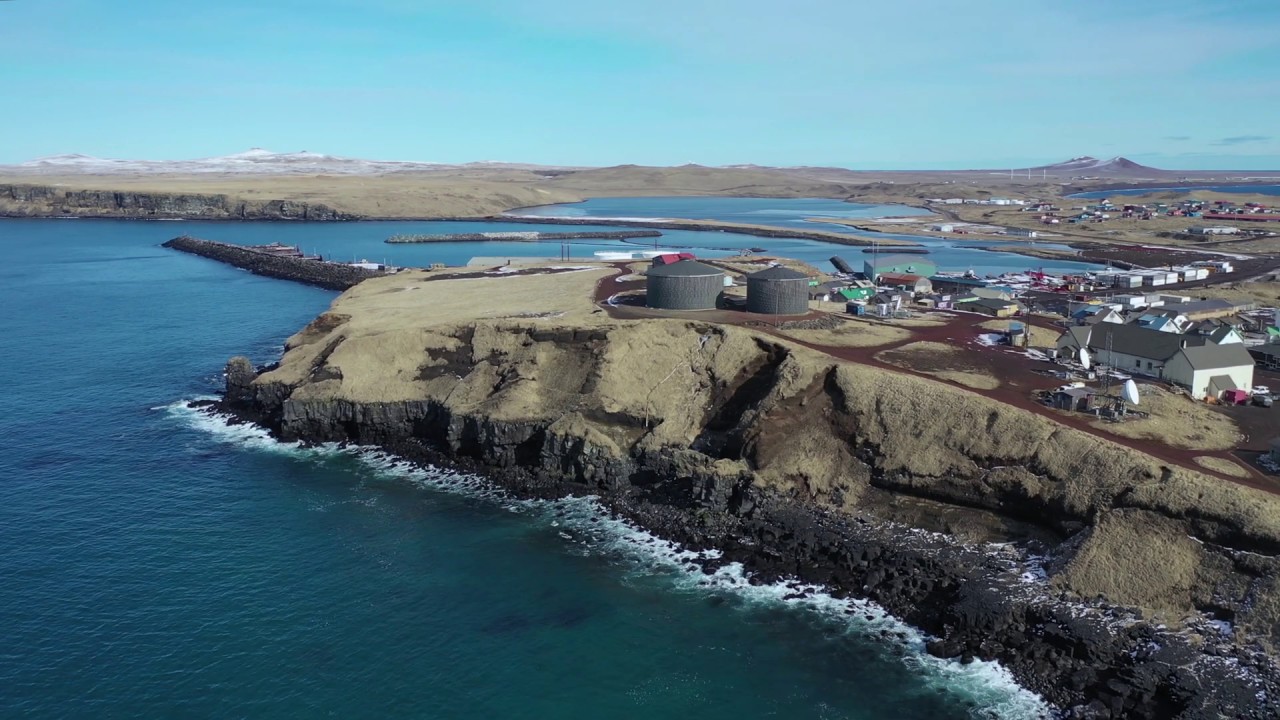
CLIFF – TOP BREEDING GROUNDS
Saint Paul Island has sandy beaches, coastal mudflats, craggy peaks of basalt rock, wet bogs, and treeless rolling hills covered with sparse tundra vegetation. Its 40 square miles (105 square km) remain a pristine, barely populated environment, but it is the surrounding Ocean that makes the island so special for birds. The cold waters around the Pribilofs are extremely rich in nutrients and support one of the world’s most productive fisheries, attracting several million seabirds from a dozen main species, as well as whales, fur seals, walruses, and sea lions. Throughout the winter, pack ice covers the Bering Sea as far south as Saint Paul. The trigger for seabirds to begin breeding is when rising temperatures force the ice front to retreat north. There are up to 19 hours of daylight at the height of summer, giving parent birds ample time to forage for their offspring. The cliff – nesting species form a complex community, in which each species uses a particular nesting zone. Narrow cliff ledges are crowded with Black – and Red – legged Kittiwakes, Northern Fulmars, Red – faced cormorants, and common and thick – billed Murres; crested and least Auklets nest among rubble at the base of the cliffs; Horned Puffins occupy deep crevices on the cliff face; and tufted puffins dig burrows on the cliff top. More than 240 species have been seen on Saint Paul in addition to seabirds, including migratory ducks, waders, and passerines.
CROWDED CLIFF LEDGE
Thick – bird Murres, also known as Brumich’s Guillemots, are the most abundant seabird on the cliffs of Saint Paul Island, crowding the cliff ledges during the breeding season.
WHAT TO SPOT
- Pectoral Sandpiper
- Ruddy Turnstone
- Tufted Puffin.
- Red – legged Kittiwake
Location: In Manu and Pauca ntanbo – provinces, southeastern Peru, in SOUTH AMERICA.
Manu is the world’s largest tropical rain forest reserve and supports a greater diversity of birds than any other national park. More than 850 species of bird have been recorded here, including many that are globally threatened. This total is equivalent to about 9 percent of all bird species in the world. On the eastern slopes of the Andes in Peru, Manu National Park and the adjacent Biosphere Reserve and Cultural Zone form a vast protected area of 7,250 square miles (18,800 square km). It comprises virtually the entire watershed of the Rio Manu and most tributaries of the Rio Madre de Dios, two of the major rivers in in the western Amazon basin. Manus extraordinary species richness is due to its altitudinal variation and range of habitats, from tundra like puna grassland and stunted elfin forest at high altitudes, to humid temperate forest and cloud forest at mid altitudes, humid upper tropical forest in the foothills, and primary rain forest and swamp forest in the lowlands. Some of the Manu’s birds, such as the Black – faced cotinga and Rufous – fronted Ant thrush, are found nowhere else, while this is among the best areas in the Amazon basin to see many other species, from tanagers to toucans, wood creepers, hummingbirds, quetzals, cotingas, and parrots. In addition to its resident birdlife, Manu hosts huge numbers of warbles and other migrant birds from North America throughout the northern winter, and in late July and August during the dry season its exposed river banks provide a valuable feeding and resting place for migrating shorebirds from North America. A highlight of the lowland rain forest at Manu is the flocks of Macaws that visit favored cliffs and river banks to lick the mineral – rich day. These flocks reach their peak in August and September. Another of Manus most spectacular birds is the Andean cock- of – the - Rock, which inhabits the frequently mist shrouded cloud forest. Classified as a World Heritage Site in 1987, Manu is famous among birdwatchers for offering one of the most intense and varied experiences anywhere is the Amazon.
FLOCKING AT CLAY – LICKS
In early morning raucous flocks of Scarlet and Red – and – green macaws assemble at clay licks, often exposed cliffs or river banks, in the lowlands of Manu National Park.

WHAT TO SPOT
- HOATZIN (Opistohocomus hoazin)
- Length: (61 – 66 cm)
- Weight: (700 g)
- Migration: Non Migrant
- Habitat: Well – vegetated river banks and edges of swamps and lakes.
An interesting bird to look at, the Hoatzin’s appearance is reminiscent of a prehistoric creature. This bird is the size of a pheasant with a spiky crest, a long neck, and a long tail. It nests in small colonies, laying 2 – 3 eggs. It is, however an unusual bird in many respects. One such oddity is that it digests its vegetation diet of leaves using bacterial fermentation, in a similar way to cows (Ruminant/ Four – chambered stomach animals). The hoatzin chicks are uniquely equipped with two claws on each of their wings. When threatened, the chicks escape by falling into the water below the nest. When the danger passes, they use the claws on their wings to clamber back to the nest.
- ORINOCO GOOSE (Neochen jubata)
- Length: (61 – 76 cm)
- Weight: (1.3 g)
- Migration: Non Migrant
- Habitat: Banks of rivers in lowland tropical forest, various wetlands in more open forest and Savanna.
A pale head and neck, dark bill, chestnut flanks, dark upperparts, and black wings with a white patch distinguish this goose. The male and female are similar in appearance. Although it spends most of its time on the ground, it readily perches in trees. It mainly grazes on grass, but will also eat mollusks, worms, larvae, and aquatic insects. It usually nests in tree hollows. The male has a high - pitched whistling call, and the female cackles like related Egyptian Goose.
- ANDEAN COCK – OF – THE – ROCK (Rupicola peruvianus)
- Length: (30 – 32 cm)
- Weight: 200 – 275g)
- Migration: Non migrant
- Habitat: Montane forest, especially in ravines.
Few birds are more emblematic of South America, or simply as beautiful as the Andean Cock – of – the – rock. The Male Andean Cock – of – the – rock has a vivid red or orange plumage with black wings, and a black tail. Due to the casquelike crest that topples forward over the bird’s forehead, it appears almost bill – less. Like many other cotingas, the female Andean cock of – the – rock is far less colorful than the Male, although its plumage is nevertheless distinctive. The female is usually deep chestnut – brown, with pale eyes and a slightly less exaggerated crest. This bird feeds on large insects, fruit, and small vertebrates.
- HARPY EAGLE (Harpia harpyia)
- Length: (89 – 105 cm)
- Weight: (4 – 9 g)
- Migration: Non migrant
- Habitat: Tropical and subtropical rain forest with unbroken tree cover.
One of the biggest and most powerful eagles, the Harpy Eagle has massive legs, feet, and talons capable of taking adult howler monkeys, small deer, and agoutis, sloths make to a third of its diet, captured as they come to the tree tops in the early mornings. The Harpy Eagle mates for life but reproduces very slowly, breeding every two three years.
Location: In northern Costa Rica, northwest of the capital, San Jose.
Costa Rica has a fabulously varied bird life. Although it is small country, 830 species of birds have been recorded there and over a quarter of its land is managed for conservation. The Monteverde Cloud Forest Preserve is a large protected area of Mountain forest in north – central Costa Rica, covering around 26,000 acres (10,500 hectares). Much of the land that now makes up the reserve was originally brought by a group of Quakers, who emigrated from the USA in 1951.
MEETING OF WEST AND EAST
Monteverde straddles the upper slopes of the Condilera de Tilaran, the spine of mountains down the center of Costa Rica. The area is a meeting place where birds from both west and east can be seen, together with a wide range of species found only in uplands. The range in altitude through the reserve brings changes in both temperature and humidity, producing six (6) main forest zones each with its own wildlife in horizontal bands up the slopes. The cloud forest that dominates the mid altitudes is by far the most spectacular habitat. Here, the air is cool and drenched with mist and rain almost all year, and the majestic trees are festooned with masses of orchids, ferns, mosses, and trailing vines. This is the home of the elusive Resplendent Quetzal. Its favorite food is the fruit of the wild avocado tree, which thrives in the cloud forest. Another fruit – eating resident is the Three – Wattled Bellbird, whose bizarre ringing call can carry over 2 miles (3 km) across the area’s forested ravines. Monteverde is on a major north – south fly way for migratory birds from North America, especially birds of prey, such as the Broad – winged Hawk, and songbirds, such as vireos and New World Warblers. Some migrants pause only briefly on their journey South, but many birds remain for several months, often forming colorful flocks with resident local species such as tanagers and euphonias.
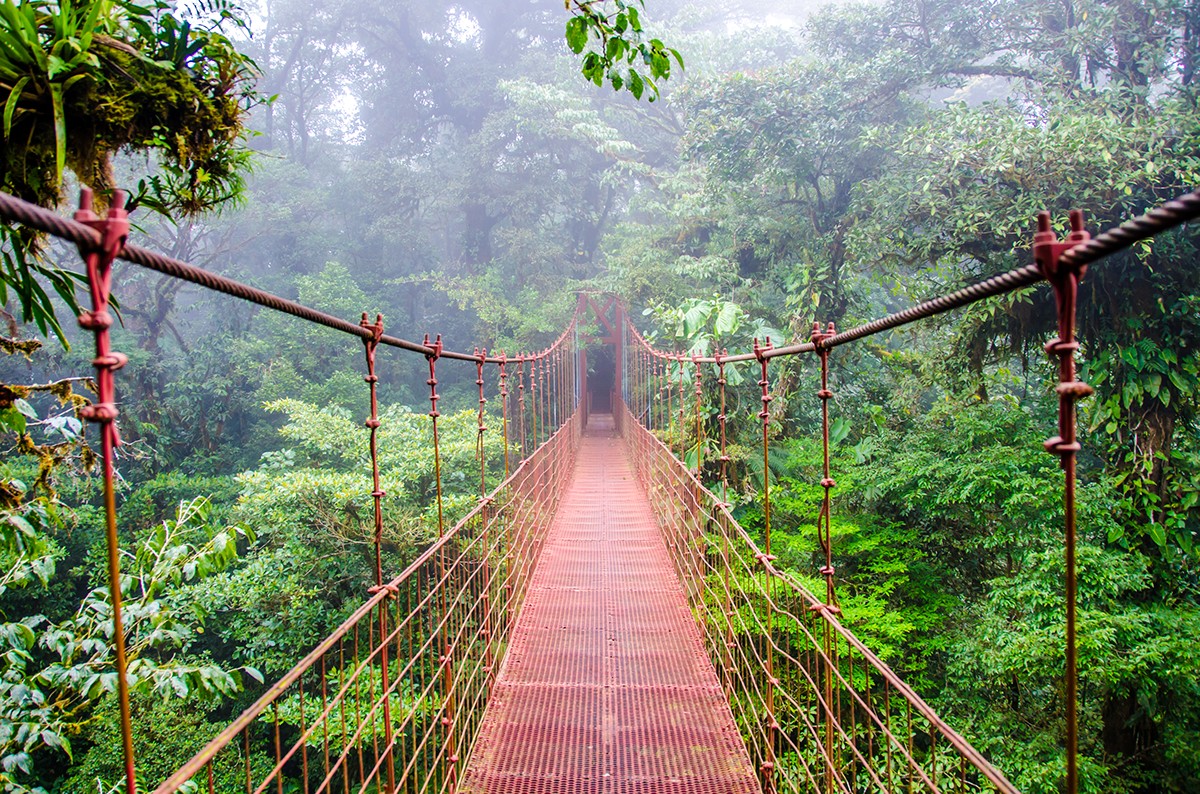
RESPLENDENT RESIDENT
One of Monteverde’s most famous residents, is the Resplendent Quetzal.
WHAT TO SPOT
- EMERALD TOUCANET (Aulacorhynchus prasinus)
- Length: (30 – 37 cm)
- Weight: (100 – 250 g)
- Migration: Non migrant
- Habitat: Wet montane forest to altitudes over 10,000 ft. (3,000 m)
As its common name suggests, the Plumage color of the Emerald Toucanet is predominantly green. Its lower face is bright blue and the upper mandible of the beak is yellow, with a purple base. The diet mainly consists of fruit, but some insects, small reptiles, and eggs of other bird species are also taken, with small flocks foraging in a trailed flight through the trees. The nest is made in an unlined tree cavity and both parents incubate the eggs.
- COMMON POTOO (Nyctibius griseus)
- Length: (35 – 38 cm)
- Weight: (150 – 175 g)
- Migration: Non migrant
- Habitat: Forest, Mangroves, Scrub, Savanna, and other open habitats with trees.
The melancholy call of the common Potoo – described as “poor me, all alone” – has misled many hearers into thinking that they were hearing a mammal, or even a human voice. Its gray – brown plumage and black and buff pattern give effective camouflage against the tree bark. With its big head and outward – bulging eyes, it can be mistaken for an owl. It feeds on insects, which it catches in the air, and nests in a knot hole or depression in a branch.
- ORANGE – FRONTED PARAKEET
- BROWN VIOLET EAR




